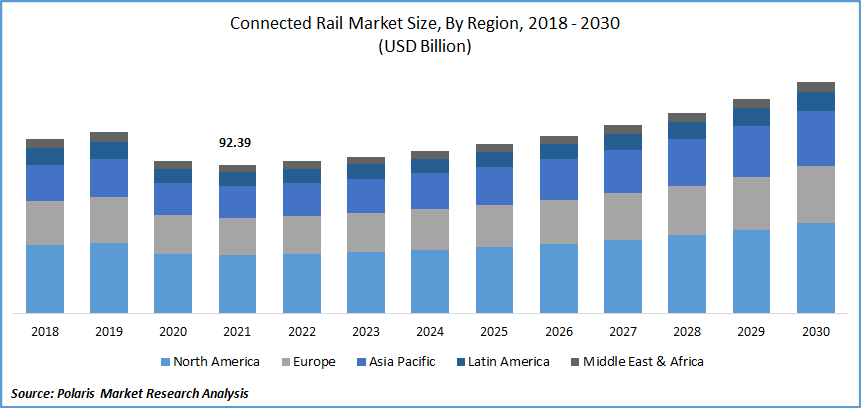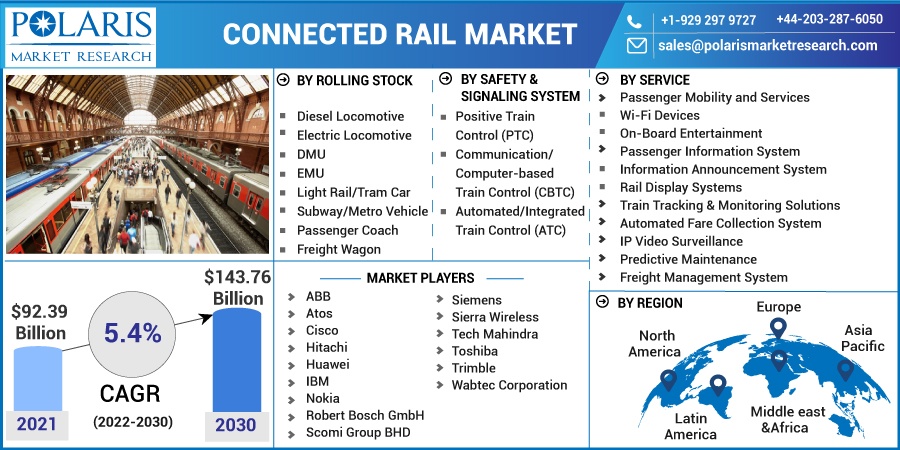
Connected Rail Market Share, Size, Trends, Industry Analysis Report, By Rolling Stock (Diesel Locomotive, Electric Locomotive, DMU, EMU, Light Rail/Tram Car, Subway/Metro Vehicle, Passenger Coach, Freight Wagon); By Service; By Safety & Signaling System; By Region; Segment Forecast, 2022 - 2030
- Published Date:Jun-2022
- Pages: 101
- Format: PDF
- Report ID: PM2477
- Base Year: 2021
- Historical Data: 2018-2020
Report Summary
The global connected rail market was valued at USD 92.39 billion in 2021 and is expected to grow at a CAGR of 5.4% during the forecast period. The major factor driving the industry growth include rapid urbanization, technological advancement as well as the rising demand for safer and more efficient mobility among consumers.
 Know more about this report: Request for sample pages
Know more about this report: Request for sample pages
The demand for the connected rail market is directly associated with the growing digital transformation along with the integration of the Internet of Things (IoT). Hundreds of sensors are included on today's locomotives, which perform a number of functions ranging from tracking internal properties such as consumable levels to external attributes such as wind speed and direction. The capacity to utilize the data that each connected piece of equipment generates to enhance efficiencies and safety while cutting costs is the future of system-level connectivity.
Furthermore, the demand for the industry is propelled by the rising environmental concern along with the need for energy conservation. The connected rail system has the potential to improve both the energy sector and the environment. It can reduce transportation energy use and carbon dioxide and local pollutant emissions by diversifying energy sources and offering more efficient mobility.
During the onset of the COVID-19, the connected rail market has experienced negative impacts owing to the factors such as stringent lockdown across the globe and transportation bans. In addition, the sluggish supply chain, as well as decreased demand, led the component manufacturers to stop the production at their manufacturing facilities which affected the growth of the industry.
Furthermore, the outbreak of the Covid-19 pandemic had a strong impact on transport and mobility. The significant impact of interpersonal distancing affected the travel demand of the masses during the period that witnessed a gradual downfall in order to reduce the spread of the contagious virus across the globe, hampering the market development.
 Know more about this report: Request for sample pages
Know more about this report: Request for sample pages
Industry Dynamics
Growth Drivers
The global need for transportation is rapidly increasing. Passenger and freight traffic is expected to be more than double by 2050 if such trends continue. Growth like this is a sign of social and economic development, but it also means more energy demand, more CO2 emissions, and more pollutants in the air. Therefore, increased reliance on connected rail could assist in slowing those challenges over the forecast period.
Connected rail travel is well suited to urban needs in a world that is getting increasingly urbanized. Short-distance air travel can be replaced by high-speed connected rail, while traditional and freight rail systems can be used along with other forms of transportation to provide efficient mobility. This factor is anticipated to accelerate the growth of the market.
In addition, the technological advancements in the connected rail sector are attributed to the growth of the market. Safety, railway control, traffic management, and automated visual monitoring on trains and platforms also benefit from connected technology. Data consumption is expected to rise as passenger traffic rises, driving demand for the connected rail market.
Report Segmentation
The market is primarily segmented on the basis of service, rolling stock, safety & signaling system, and region.
|
By Service |
By Rolling Stock |
By Safety & Signaling System |
By Region |
|
|
|
|
Know more about this report: Request for sample pages
Insight by Rolling Stock
The freight wagon is anticipated to lead the global market over the forecast period. The connected rail system's new technologies are expected to drive the market's expansion. In order to track their movement in real-time and provide information to the parties who are booking the wagons, the railways of several economies have made the decision to equip their rolling stock of freight wagons with GPS.
Passenger Coach is expected to account for a significant share in the global market over the forecast period. The growth of the segment is attributed to the rapid increase in travel leading to the increased demand for the passenger coaches in the railway system. Furthermore, in order to manage the passenger inflow, Indian railways are increasing the number of coaches in the system, which in turn, boosts the market growth.
Geographic Overview
North America is projected to account for the largest market over the forecast period. The connected railway sector and the commuter experience are expected to change as a result of ongoing developments in data management applications and advanced analytics. The connected rail industry is anticipated to have significant growth potential as a result of the Internet of Things (IoT) expanding usage. In order to increase network connectivity, technology and telecom companies are working together.
Asia Pacific is projected to account for a significant share over the forecast period. The high growth in the region is associated with the factors such as rising passenger demand, increasing focus of railway operators and authorities on providing a safe passenger experience as well as supporting connected rail transformation.
Competitive Insight
Some of the major players operating in the global market include ABB, Atos, Cisco, Hitachi, Huawei, IBM, Nokia, Robert Bosch GmbH, Scomi Group BHD, Siemens, Sierra Wireless, Tech Mahindra, Toshiba, Trimble, and Wabtec Corporation.
For instance, in June 2019, Huawei launched a series of ICT solutions according to the needs of urban connectivity in digital time. For fully connected rail transportation, Huawei released its 5G Digital Indoor System (DIS) solutions, Urban Rail Light Cloud, as well as LTE-Railway (LTE-R) Solution, which were jointly released with Tianjin 712 Communication & Broadcasting Co., LTD. (TCB 712) for next general rail wireless communications at the UITP Global Public Transport Summit 2019.
Connected Rail Market Report Scope
|
Report Attributes |
Details |
|
Market size value in 2021 |
USD 92.39 Billion |
|
Revenue forecast in 2030 |
USD 143.76 Billion |
|
CAGR |
5.4% from 2022 - 2030 |
|
Base year |
2021 |
|
Historical data |
2018 - 2020 |
|
Forecast period |
2022 - 2030 |
|
Quantitative units |
Revenue in USD Billion and CAGR from 2022 to 2030 |
|
Segments covered |
By Service, By Rolling Stock, By Safety & Signaling System, By Region |
|
Regional scope |
North America, Europe, Asia Pacific, Latin America, Middle East & Africa |
|
Key companies |
ABB, Atos, Cisco, Hitachi, Huawei, IBM, Nokia, Robert Bosch GmbH, Scomi Group BHD, Siemens, Sierra Wireless, Tech Mahindra, Toshiba, Trimble, and Wabtec Corporation |
License and Pricing
Purchase Report Sections
- Regional analysis
- Segmentation analysis
- Industry outlook
- Competitive landscape
Connect with experts
Suggested Report
- Halal Food Market Research Report, Size & Forecast, 2018 – 2026
- Urgent Care Apps Market Share, Size, Trends, Industry Analysis Report, 2020-2027
- Patient Referral Management Software Market Share, Size, Trends, Industry Analysis Report, 2022 - 2030
- Gene Delivery Technologies Market Share, Size, Trends, Industry Analysis Report, 2021 - 2028
- Advanced Ceramics Market Share, Size, Trends, Industry Analysis Report, 2022 - 2030

